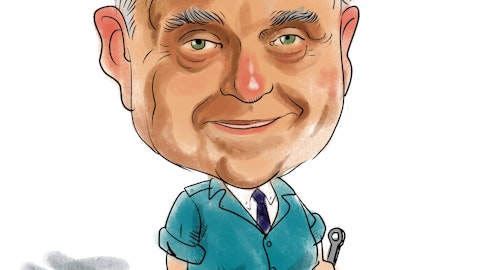Arbor Realty Trust, Inc. (NYSE:ABR) Q4 2023 Earnings Call Transcript February 16, 2024
Arbor Realty Trust, Inc. misses on earnings expectations. Reported EPS is $0.00041 EPS, expectations were $0.48. Arbor Realty Trust, Inc. isn’t one of the 30 most popular stocks among hedge funds at the end of the third quarter (see the details here).
Operator: Good morning, ladies and gentlemen, and welcome to the Fourth Quarter and Full Year 2023 Arbor Realty Trust Earnings Conference Call. All participants are in a listen-only mode. After the speakers’ presentation, there will be a question-and-answer session. [Operator Instructions]. Please be advised that today’s conference is being recorded. [Operator Instructions]. I would now like to turn your call over to your speaker today, Paul Elenio, Chief Financial Officer. Please go ahead.
Paul Elenio: Okay. Thank you, Savannah, and good morning, everyone, and welcome to the quarterly earnings call for Arbor Realty Trust. This morning, we’ll discuss the results for the quarter and year ended December 31, 2023. With me on the call today is Ivan Kaufman, our President and Chief Executive Officer. Before we begin, I need to inform you that statements made in this earnings call may be deemed forward-looking statements that are subject to risks and uncertainties, including information about possible or assumed future results of our business, financial conditions, liquidity, results of operations, plans and objectives. These statements are based on our beliefs, assumptions and expectations of our future performance, taking into account the information currently available to us.
Factors that could cause actual results to differ materially from Arbor’s expectations in these forward-looking statements are detailed in our SEC reports. Listeners are cautioned not to place undue reliance on these forward-looking statements, which speak only as of today. Arbor undertakes no obligation to publicly update or revise these forward-looking statements to reflect events or circumstances after today or the occurrences of unanticipated events. I’ll now turn the call over to Arbor’s President and CEO, Ivan Kaufman.
Ivan Kaufman: Thank you, Paul, and thanks to everyone for joining us on today’s call. As you can see from this morning’s press release, we had another outstanding quarter and closed out an exceptional 2023. In fact, 2023 was one of our best years as a public company despite an extremely challenging environment. We managed to increase our dividend twice while maintaining one of the lowest payout dividend ratios in the industry and generated a total shareholder return of 28% outperforming our peers. Additionally and very significantly, we’re able to maintain our book value of our recording reserves for potential future losses, which clearly differentiates us from everyone in this space. In fact, as Paul will discuss in more detail later, we generated GAAP earnings in excess of our dividend in 2023 despite recording approximately 90 million in reserves and our distributable earnings were also well in excess of our dividend, providing one of the best dividend coverages ratios in the industry.
We’re also very effective in refinancing loans off our balance sheet through our capital-light Agency Business. We generated 3 billion of multifamily runoff in 2023 and recaptured 56% or 1.7 billion of those loans in new agency product. Our agency platform gives us a tremendous strategic advantage, allowing us to continue to delever our balance sheet and generate significant long-dated income streams, which is a key part of our business strategy. We have been a significant player in the Agency Business for almost 20 years and now have been a top 10 Fannie Mae DUS lender for 17 years in a row coming in at number 6 for 2023, and it’s extremely important to emphasize that our Agency Business generates over 40% of our net revenues, the vast majority of which occur before we even open our doors every day.
This is completely unique to our platform and is something we feel is not fully reflected in our valuation. On our last call, we gave guidance that the fourth quarter of last year and the first quarter and second quarter of this year would be the most challenging part of the cycle. We are in a period of peak stress and expect the next two quarters to be challenging, if not more challenging than the fourth quarter. As a result of this environment, we are experiencing elevated delinquencies. One of the many reasons this is occurring is certain borrowers are taking the position that they will default first and negotiate second which is not a strategy that works well with us. Second, borrowers need to bring capital to the table to right-size their deals and raising capital is a lengthy process in today’s climate.
Therefore, you will see defaults rise initially until are able to raise additional capital and then deals will often be recapped. We feel we have done a very good job to-date in collecting payments and have been highly effective in refinancing deals for our Agency Businesses as well as getting borrowers to recapitalize their deals and purchase interest rate caps where appropriate. In fact, we had 2.5 billion of loans with interest rate caps that were expiring over the last four months, of which 1.7 billion executed new rate caps will put cash up in lieu of caps, and we continue to work on getting new caps executed every day. We also have longstanding relationships with many quality sponsors that we’ve been working with to step in and take over assets that are underperforming and assume our debt and recap these transactions.
As we are constantly receiving reverse increase in the market to purchase our assets as well, our goal is to maximize shareholder value. And very often, it’s not just the value of the collateral, but the recourse provisions that we evaluate in determining how to approach each individual circumstance. The short-term nature of having a delinquent loan will not impact our decision-making process to achieve a correct economic result on a transaction. With that said, we’ve received a lot of public criticism in what we consider to be an extremely successful transition of assets to new ownership through the legal process or even through cases consciously. This is a very difficult and complicated work. And I said earlier, we expect to be extremely busy in the first two quarters of this year, managing through the most challenging part of this dislocation.
Additionally, we continue to focus heavily on maintaining a very strong liquidity position. We currently have over 1.1 billion of cash between 1 billion in corporate cash and 600 million of cash in our CLOs that results in an additional cash equivalent of approximately $150 million. And having this level of liquidity is crucial in this environment as it provides us the flexibility needed to manage through the rest of the downturn and take advantage of opportunities that will exist in the market to generate superior returns on our capital. We have also done an excellent job in reducing our exposure to short-term bank debt and have no significant pending maturity to deal with on any of our warehousing facilities. We are down to approximately 2.8 billion in outstandings with our commercial banks from a peak of nearly 4.2 billion, and we have over 70% of our secured indebtedness and non-mark-to-market, non-recourse, low-cost CLO vehicles.
As previously discussed, these vehicles provide a tremendous strategic advantage at times of distress and dislocation, like the environment we are in today, due to the nature of that non-mark-to-market, non-recourse elements. In addition, they contribute significantly to providing a low-cost alternative to warehouse banks which in times like this have fluctuating pricing and leverage point parameters. Turning now to the fourth quarter performance. As Paul will discuss in more detail, our quarterly financial results are once again remarkable. We produced distributable earnings of $0.54 per share, excluding a one-time realized gain on an office property that we had previously reserved for. The results were well in excess of our current dividend, representing a payout ratio of around 80%.
We are very pleased with the substantial cushion we have created between our earnings and dividends, which will serve us well through the balance of this dislocation. We believe our diverse business model uniquely positions us as one of the only companies in this space with the ability to continue to provide a sustainable dividend and just as importantly, at a time of tremendous stress, we’ve managed to maintain our book value while recording reserves for potential future losses, which clearly differentiates us from our peers. In our balance sheet lending business, we continue to focus on working through our loan book and converting our multifamily bridge loans into agency product allowing us to recapture a substantial amount of our invested capital and produce significant long-dated income streams.
In the fourth quarter, we were able to again be highly effective with this strategy, producing another 800 million of balance sheet runoff, 465 million or 58% of which was recaptured to new agency loan originations. As a result, we recouped over 100 million of capital and continue to build up our cash position, which again currently sits at around $1.1 billion. With today’s current interest rates, we will continue to chip away at converting loans to the agencies. But if the 10-year goes below 4% again, it will become more meaningful and every quarter of a point drop in rates from here will be even more impactful. As we touched upon last quarter, we also believe we are well positioned to step back into the lending market and done [ph] accretive opportunities continue to grow our platform.
We feel now is an appropriate time to originate some of the highest quality loans with attractive returns, allowing us to grow our balance sheet and build our pipeline of future agency deals. In our GSE/Agency Business, we had another great quarter and an exceptional 2023 despite elevated interest rates. We originated 1.3 billion in fourth quarter and 4.8 billion for the full year, representing a 7% increase over our 2022 numbers. This is a tremendous accomplishment in light of the fact that the agencies were down 25% to 30% in production year-over-year. We have done an excellent job in gaining market share and converting our balance sheet loans at the agency product which has always been one of our key strategies and a significant differentiator from our peers.

We also originated 300 million of five to 10-year fixed rate GSE/Agency alternative products through our private label business, bringing our total agency volume to 5.1 billion for 2023. Traditionally, January is a much slower month with the agencies, which resulted in us originating 250 million of loans. February numbers are looking much stronger. We have a large pipeline, setting us up for what we believe will be another very solid year in agency originations for 2024. And again, as Agency Business offers a premium value as it requires limited capital and generates significant long-dated, predictable income stream and produces significant annual cash flow. To this point, our 31 billion fee-based servicing loan portfolio, which grew another 4% in the fourth quarter and 11% year-over-year generates approximately $121 million a year in reoccurring cash flow.
We also generate significant earnings on our escrow and cash balances, which acts as a natural hedge against interest rates. In fact, we are now earning 5% and around 3 billion in balances, roughly 150 million annually, which combined with our servicing income annuity totals approximately 270 million of annual gross earnings or $1.30 a share. This is in addition to the strong gain on sale margins we generate from our originations platform, providing us a strategic advantage over our peers. In our single-family rental business, we had a very strong fourth quarter and a full year 2023 as we continue to dominate this space and become a lender of choice in the premium markets we traffic in. We had 200 million of fundings and another 470 million of commitments signed up in the fourth quarter and closed out 2023 with 1.2 billion of new commitments.
We also have a large pipeline and remain committed to this business as it offers us 3 turns on our capital through construction, bridge and permanent lending opportunities and generates strong levered returns in the short term, while providing significant long-term benefits by further diversifying our income streams. We’re also very excited about the opportunities we think we can garner from our newly added construction lending business as we believe we can generate 10% to 12% unlevered returns on our capital and eventually leverage this business and produce mid to high-teens returns. We continue to build up a pipeline of potential deals and now have roughly 44 million on new application, another 400 million in NOIs and a significant number of additional deals we are currently screening.
We believe this product is very appropriate for our platform as it offers us 3 turns on our capital through construction, bridge and permanent agency lending opportunities. Lastly, I would like to spend some time talking about the short reports that have been written on our company. One our loyal investors base to understand that these reports are written in a way that is purposely designed to drive down the company’s stock price to achieve the desired goal of profit from a short position. As such, the facts, assumptions, predicated future events and marketing conditions as well as conclusions in these reports are exaggerated, laced with incomplete and inaccurate data, and slanted only to provide a negative view on Arbor and again, purely for personal gain.
And while we will not get into a back and forth on the information in these reports or have detailed discussions on any specific loans, what we will point out is that the show reports state that our CLO delinquencies were 16.5% in December and 26.6% in January, when in reality, the rate of 1.3% for December and 5.6% for this January and as of today. More importantly, the 30-day delinquency numbers are 0.9% for December and 1.2% for January as of today, which are the numbers the industry focuses on. This is a perfect example of using select data as of a point in time, does not contain the full picture or represent the industry’s focus only to inject fear into the market for personal gain. We urge our long-term shareholders to know these one-sided self-motivated reports and focus only on our results and public disclosures and the fact that we’ve consistently outperformed our peers.
It is also very important to emphasize that a significant portion of Arbor’s lending is multifamily focused, specifically in the workforce housing part of the market. As we all know, Fannie Mae and Freddie Mac have had a specific mandate to address the workforce/affordable housing needs, which is a major issue in the United States, making Arbor a great partner. This product requires a level of — a high level of management, tremendous expertise, which we have been effective at for decades, because this product may not have the same curb appeal as other multifamily product types, we’ve been criticized for a core part of our business that we have been extremely effective at and we’ll continue to fulfill a very important mandate for the federal agencies, as well as the social needs for society.
Again, we thank you for your continued support. And now I will turn the call over to Paul to take you through our financial results.
Paul Elenio: Okay. Thank you, Ivan. As Ivan mentioned, we had another very strong quarter, producing distributable earnings of $104 million or $0.51 per share and $0.54 per share, excluding a $7 million onetime realized loss in an office property that we had previously reserved for. These results translated into industry high ROEs, again, of approximately 17% for the fourth quarter and 18% for the full year of 2023. Equally as important, we closed out 2023 with GAAP EPS of $1.75 a share which was in excess of our dividend, despite booking approximately $90 million of reserves for potential future losses. And of course, with distributable earnings of $2.25 a share that easily beat our dividend run rate, we provided a very strong dividend to earnings coverage ratio for our investors.
Our fourth quarter results were positively affected by a $5 million distribution from our Lexford investment, which was recorded in income from equity affiliates. We also had higher gain on sale income as our agency volumes are typically stronger in the fourth quarter and we continue to benefit from strong earnings on our escrow and cash balances from elevated interest rates. As Ivan mentioned, we do expect to continue to experience stress as we manage through the most challenging part of the cycle. As a result, we continue to build our reserves, recording an additional $23 million in CECL reserves in our balance sheet loan book during the quarter which was slightly offset by a $3 million recovery we had from a payoff of a nonperforming loan that we had fully reserved for previously.
As to be expected in this market, we also experienced a net increase in our delinquencies in the fourth quarter of approximately $115 million. And as discussed earlier, we are expecting that we will experience additional delinquencies over the next few quarters. Very important to emphasize that despite booking approximately $90 million in CECL reserves across our platform in 2023, $74 million of which was in our balance sheet business, we still grew our book value 2% to $12.80 a share from $12.50 a share last year. And we are one of the only companies in our space that has significant book value appreciation over the last 3 years with roughly 30% growth from around $10 a share to nearly $13 a share. In our Agency business, we had a very strong fourth quarter with $1.4 billion in originations and $1.3 billion in loan sales.
The margin on these loan sales came in at 1.32% this quarter, compared to 1.46% last quarter, mainly due to some larger deals in the fourth quarter. We were very incredibly pleased with the margins we generated in 2023 of 1.48%, which exceeded 2022 pace of 1.34% by 10%. We also recorded $21.1 million of mortgage servicing rights income related to $1.4 billion of committed loans in the fourth quarter, representing an average MSR rate of around 1.55%, compared to 1.16% last quarter, mainly due to a higher percentage of Fannie Mae loan commitments in the fourth quarter, which contain higher servicing fees. Our fee-based servicing portfolio also grew another 3.5% in the fourth quarter and 11% year-over-year to approximately $31 billion at December 31 with a weighted average servicing fee of 39 basis points and an estimated remaining life of eight years.
This portfolio will continue to generate a predictable annuity of income going forward of around $121 million gross annually. And this income stream, combined with our earnings on our escrows and gain on sale margins represented over 40% of our 2023 net revenues. In our balance sheet lending operation, our $12.6 billion investment portfolio had an all-in yield of 8.98% at December 31 compared to 9.12% at September 30 due to a combination of an increase in nonperforming loans, and loans that had not made their full payments as of December 31 that we did not fully accrue for. The average balance in our core investments was $13 billion this quarter compared to $13.4 billion last quarter due to runoff exceeding originations in the third and fourth quarters.
The average yield on these assets increased slightly to 9.31% from 9.28% last quarter due to a slight increase in sulfur, which was offset by an increase in nonperforming loans in the fourth quarter. Total debt on our core assets decreased again to approximately $11.6 billion at December 31 from $11.9 billion at September 30. The oil in cost of debt was relatively flat at 7.45% at 12/31 versus 7.41% at 9/30. The average balance on our debt facilities was approximately $11.8 billion for the fourth quarter compared to $12 billion last quarter, and the average cost of funds on our debt facilities was 7.48% for the fourth quarter compared to 7.37% for the third quarter, primarily due to increases in the benchmark index rates. Our overall net interest spreads in our core assets decreased to 1.83% this quarter compared to 1.91% last quarter, and our overall spot net interest spreads were down to 1.53% at December 31 from 1.71% at September 30 again, due to an increase in delinquencies and nonaccrual loans during the quarter.
And as I mentioned earlier, we are expecting to experience additional delinquencies over the next few quarters, which could further reduce these margins. Lastly, as we continue to shrink our balance sheet loan book by moving loans to our agency business, we have delevered our business 18% in 2023 to a leverage ratio of 3.3:1 from around 4.0:1 last year. Equally as important, our leverage consists of over 70% non-recourse, non-mark-to-market CLO debt with average pricing of $1.70 over, which is well below the current market, providing strong leverage returns on our capital. That completes our prepared remarks for this morning, and I’ll now turn it back to the operator to take any questions you may have at this time. Operator?
See also 16 Best Beach Towns to Buy a House/Apartment in USA and Top 20 Companies With the Most Cash Reserves.
Q&A Session
Follow Arbor Realty Trust Inc (NYSE:ABR)
Follow Arbor Realty Trust Inc (NYSE:ABR)
Operator: [Operator Instructions]. Our first question will come from Steve Delaney with Citizens JNP.
Steve Delaney: Good morning, Ivan. Thank you. Good morning, Ivan and Paul. Start off, if I may, with a quick question for Paul. Thanks for the details on the NPLs up to 16 assets from 12 foreclosures is something we haven’t — it’s certainly part of your tool kit, but not something we’ve seen a lot. Should we expect over the next several quarters as you attempt to maximize your outcome that we will see more actual — you actually taken over properties? And do you have — are you confident you have the internal ability to operate those projects and resolve them without the current borrower? Thanks Paul.
Ivan Kaufman: So let me take that first, Steve. We have options to either go through the legal process of foreclosure to do them consensually. It’s always better to do things consensually if you can, but sometimes the process is an alternative and certainly, in certain jurisdictions, it’s very easy to do so. With respect to us taking over the management of the assets, we do have the capability, but that’s not what’s that’s not what’s taking place. In fact, the demand from our borrowers to step into some of these assets is so strong that we’ve had to set up an internal process to limit the number of actual borrowers that we have because we’re getting inundated requests. So we’ve set up an internal process that when we do have a stressed asset or a stress borrower, borrower, we don’t think it’s going to be able to bring the asset to the finish line to bring in a new borrower and whether it be through a consensual process or through the legal process, we have somebody lined up willing to step in and that’s how we’ve done it.
So maybe six or nine months ago when there was a lot of fear in the market of where our value is going to go and the lack of liquidity, it was much harder to get somebody to the table. Clearly to get people to the table is very easy and as you can see, people are raising distressed funds and there’s plenty of cap, plenty of liquidity to step in. So we have that capability, and we’ve set up the process.
Steve Delaney: Excellent Paul, anything you want to add there?
Paul Elenio: No. I think I definitely took you through everything that we worked through internally.
Steve Delaney: So yes, it just sounds like the — the opportunistic private capital and your relationships in the industry that you’re going to have opportunities to resolve either working with the existing borrower or bringing in a new player that we probably won’t see a lot of dead foreclosured REO properties on your balance sheet where trying to figure out a plan. It sounds like you’ve got the plans in place very accurately?
Ivan Kaufman: Yes, generally not. Generally, by the time we foreclosed the thing has been prebaked and pre-done in that set — and you really get to see assets that haven’t had the right management, that’s why it’s so important to us when an asset isn’t performing not just kick the can down the road because the asset will deteriorate, but to really accelerate either a change in management or change in ownership.
Paul Elenio: Steve, yes, as Ivan said, we don’t have a lot of REO in our book, as you know. We did this quarter and we didn’t put it in our commentary, we did have an office asset that we had written loan. We took back that asset this quarter. It is an REO, and we brought in a very sophisticated partner who has a lot of experience in converting that building to condo. And so we’re working through that process over the next couple of years. So that’s an exception where we will take an asset back in REO. It’s just not a big part of our business, as Ivan said, but you will see that in our filings when we file our CAD.
Steve Delaney: Okay. So Ivan, on your point, this is kind of strategic, and I am speaking directly to some of the short reports I think early on, maybe there was a Houston assets, someone used the term slumlord to describe your portfolio, your three bites out of the apple strategy that you’ve used forever. Do you have any concern that the overall quality of your loans or borrowers, and I don’t mean a large percentage, but do you think you have some assets, loans in your portfolio that are not of sufficient quality to be refinanced into with permanent financing into Freddie Mac and Fannie Mae? That’s it for me. Thanks.
Ivan Kaufman: Well, clearly, our agenda is when we do a bridge loan it’s for the sole purpose of creating an agency loan. You have to have a quality sponsor and you have to have a quality asset. So our idea, of course, is that every sponsor that we take on is going to perform correctly, not all sponsors do that and a lot of — sometimes they’ll be a sponsor who couldn’t hit his business plan or who had all the problems or isn’t what we thought and they don’t qualify, that’s just the way it goes. Nobody is perfect. We’re not perfect. With respect to the assets, if you’re improving an asset, you got to approve that asset and you got to get it up to industry standards and the agency standards. If it doesn’t, it won’t meet that agency eligible.
So if we have a $16 billion portfolio, not all $16 billion is going to make that mark. I mean I think of 75%, 80% of them get to an agency status and convert, that’s pretty good. In other cases, when they don’t do that, the assets will be sold or put into new ownership who will get that asset up to spec, so that’s kind of the way we look at the world. It’s not a perfect situation where every asset that we take in ends up meeting our execution.
Steve Delaney: But you have other options to resolve it? It sounds like product…
Ivan Kaufman: We have other options and bringing in new ownership very often they can get the assets up to speed and get them repaired and get them fixed and we’ve had many assets where on the one form of ownership that couldn’t get there, you bring another form of ownership. It gets there very, very quickly. In fact, one of the assets that we transitioned in Atlanta for ownership. And I think within nine months, the assets almost ready to go agency, whereas with your other ownership, we had no chance between the owner and the way it was operating. It only took nine months to turn the asset around.
Steven Delaney: Thank you both for your comments this morning.
Ivan Kaufman: Thanks Steve.
Operator: Our next question will come from Jay McCanless with Wedbush. Please go ahead.
Jay McCanless: Hi. Good morning. Thank you for taking my questions. Provisioning was a little less than what we were expecting this quarter. But it sounds like things may get a little rockier heading into the beginning of ’24. Just could you maybe talk a little bit more about why some borrowers feel it’s better to default than negotiate first? That seems to be a little backwards given the environment that we’re in right now?
Ivan Kaufman: I can speak from experience, I deal with a lot. I’m pretty involved in the asset management side with the asset management group. I think are being cancelled that if you default, the lenders will be more, more easy to work with, they don’t want the faults on their books. That’s number one. And that may work with other lenders. It doesn’t work with us. We’re not afraid of defaults don’t intimidate us. And they may intimidate other lenders. That’s number one. Number two, for whatever reason, and I’m not sure why initially, people don’t think that the recourse provisions on their loan are applicable. And when they get notification of what they’re triggering, they really wake up very, very quickly. I don’t believe other lenders in the prior years had the structural enhancements that we at all, but do have on our loans.
They do now. They’ve learned. But we’ve always had the structural enhancements on our loans, which include, in many cases, interest reserve replenishment, recourse obligations on rebalance and caps and very, very significantly majority of a default interest rate on loans of 24%. So I think it puts us in a different light, maybe when they have loans with other lenders, lenders act differently than we do, but this is our course of conduct. If a borrower has a problem, we advise them, let us know what your issue is. We’re happy to figure out how to try and come up with a solution in a proper way. And that’s always the best act, and then we’ll give you time to figure out how to recap and work with you. But we did definitely see a spike of a mentality of default.
And then here are the keys and it’s your problem and immediately, we let them all of their obligations and we’re able to bring that mentality and correct that mentality.
Jay McCanless: Great. Thank you, Ivan. The other question that I had, when we look at multifamily rents, especially in Texas and Florida, we’ve started to see some of the cities are holding up, but some of the cities are starting to see year-over-year rent declines. I guess, could you maybe talk about what type of geographic risk we should be monitoring right now and how you’re feeling about that part of the country in terms of potential delinquencies and workouts you’re going to have to address there?
Ivan Kaufman: I think we’re through the worst of it, and I think in my prior calls, I talked a little bit about the economic vacancy that exists specifically in certain areas. And I think there’s a large economic vacancy, which has been created from COVID backlog and the cost mentality with some of the renters, they can be in an apartment, not pay rent and not get affected. I also think that there was a period of time from COVID that people got rent subsidies and those rent subsidies right now, and that also accelerated a lot of the delinquencies. The courts are starting to be a little easier to work with tenants are being evicted at a much more rapid pace. And I think that you’ll see the economic vacancy start to diminish without a doubt.
I do want to differentiate between the product type that we have, which is a lot of workforce housing, which I think is a huge shortage versus the Class A market, which I think is suffering from different headwinds. I think if you look at the deliveries in 2023 of new construction and then the deliveries in 2024, I think you’ll see continued headwinds for Class A. I think for I think, for the workforce housing, there is a shortage. We all know there’s a shortage. I think when the court system thoughts being more efficient. And I think that the economic numbers will look a little better. I also think there’s another shadow issue, which we’ve talked about internally I mean, basically, you have 8 million or 9 million people who have come across the board of all living in hotels.
These people have to go live somewhere. They can’t live in hotels forever. We think they — once they start to begin to get their work permits and start to work, I think that, that will have a positive impact on the vacancy factors and workforce housing.
Jay McCanless: That’s great. Thank you, Ivan. Appreciate it.
Ivan Kaufman: Thank you, Jay.
Operator: Our next question will come from Jade Rahmani with KBW. Please go ahead.
Jade Rahmani: Thank you very much. The delinquency statistics you gave are much lower than the info available from the CLOs. And I wanted to ask what the — what the main discrepancy is there that you see. Just so we’re clear, the numbers you gave, are those the 30-day plus delinquency rates? Is that what you want us to focus on? If you could just clarify that?
Paul Elenio: Sure, Jade, it’s Paul. So yes, so the delinquency numbers that are reported with the CLOs, as we said in our commentary, we’re 16.5% in total delinquencies for December and 26.6% in total delinquencies for January. Those numbers, total delinquency numbers are down to 1.3, as we said in our commentary today. So we’ve resolved a lot of those loans, okay? And they’re down to — for the January numbers, I have them right here, they’re down to 5.6%. However, those are total delinquency numbers. The industry normally looks at anything 30-plus and really more importantly, 60-plus. So what we’re telling you is those total delinquency numbers that we reported on those days, are down significantly from when those numbers were reported.





